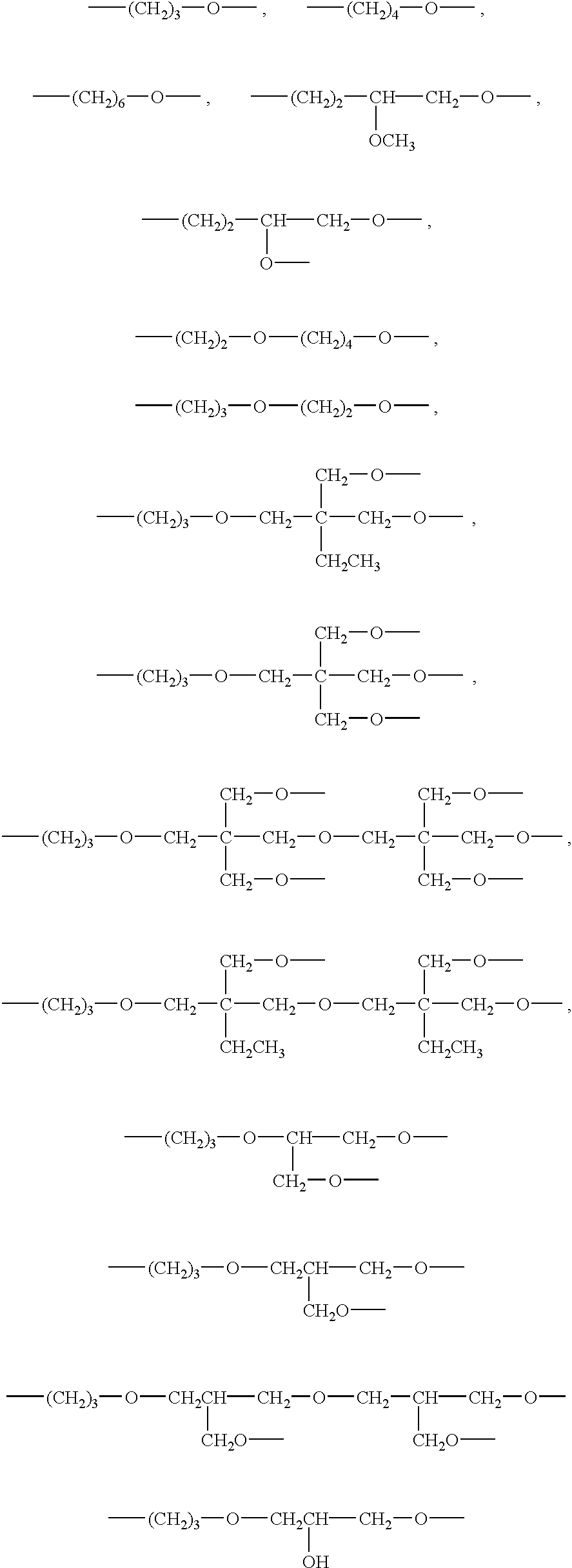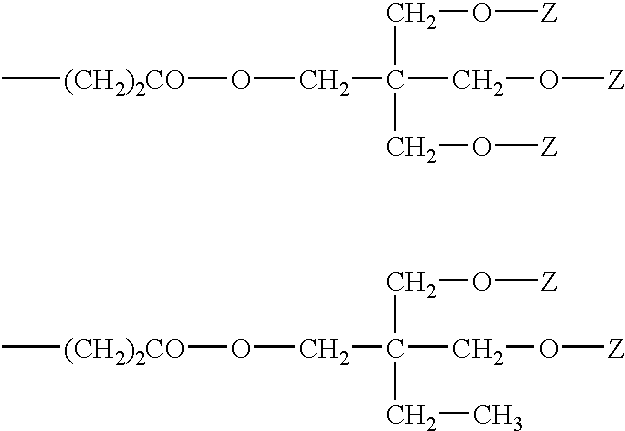Siloxane-containing compositions curable by radiation to silicone elastomers
a technology of silicone elastomers and compositions, which is applied in the direction of impression caps, transportation and packaging, printing, etc., can solve the problems of reducing cure time, difficult and slow curing and processing of these gums, and reducing the time of curing to form rubber, so as to reduce the possibility of undesirable migration, reduce the possibility of curing time, and reduce the effect of curing speed
- Summary
- Abstract
- Description
- Claims
- Application Information
AI Technical Summary
Benefits of technology
Problems solved by technology
Method used
Image
Examples
example 1
[0115] 11300 g of octamethylcyclotetrasiloxane and 45 g of acrylate-functional siloxane copolymer 1 are charged to a planetary type mixer equipped with heating jacket, thermometer and rated for vacuum operation. Start mixer at a low mixing speed. Once mixer is sealed, nitrogen flow is added and temperature is increased to 80.degree. C. Once reaction temperature is stable at 80.degree. C., 16 g of trifluoromethanesulfonic acid is added. Re-seal mixer and continue nitrogen flow. Allow polymer to equilibrate for 4 hours after onset of polymerization. Cool polymer and remove from mixer at room temperature. (pending: neutralization details) Product is a high molecular-weight gum-like silicone polymer of average chain length .about.5000, suitable for use in Electron Beam and Ultra-Violet cured compositions.
example 2
[0116] Charge 11575 g of octamethylcyclotetrasiloxane and 75 g of acrylate-functional siloxane copolymer 1 to a planetary type mixer equipped with heating jacket and rated for vacuum operation starting the mixer at low speed. Add a nitrogen atmosphere to the vessel once the mixer is sealed and increase reaction temperature to 80.degree. C. When temperature is reached, 16 g of trifluoromethanesulfonic acid is added. Once addition is complete, re-seal mixer and continue nitrogen flow. Allow polymer to equilibrate for 4 hours after onset of polymerization. Cool polymer and remove from mixer at room temperature. Product is a high molecular-weight silicone polymer of average chain length .about.3000, suitable for use in Electron Beam and Ultra-Violet cured compositions.
example 3
[0117] 11273 g of octamethylcyclotetrasiloxane and 77 g of acrylate-functional siloxane copolymer 2 are charged to a planetary type mixer equipped with heating jacket and rated for vacuum operation. Beginning speed is low. Seal mixer, add nitrogen flow and reaction temperature is increased to 80.degree. C. Once mixer and contents reach 80.degree. C., add 16 g of trifluoromethanesulfonic acid. Re-seal mixer and continue nitrogen flow. Allow polymer to equilibrate for 4 hours after onset of polymerization. Cool polymer and remove from mixer at room temperature. Product is a high molecular-weight silicone polymer of average chain length .about.2500, suitable for use in Electron Beam and Ultra-Violet cured compositions.
PUM
| Property | Measurement | Unit |
|---|---|---|
| temperature | aaaaa | aaaaa |
| diameter | aaaaa | aaaaa |
| wt % | aaaaa | aaaaa |
Abstract
Description
Claims
Application Information
 Login to View More
Login to View More - R&D
- Intellectual Property
- Life Sciences
- Materials
- Tech Scout
- Unparalleled Data Quality
- Higher Quality Content
- 60% Fewer Hallucinations
Browse by: Latest US Patents, China's latest patents, Technical Efficacy Thesaurus, Application Domain, Technology Topic, Popular Technical Reports.
© 2025 PatSnap. All rights reserved.Legal|Privacy policy|Modern Slavery Act Transparency Statement|Sitemap|About US| Contact US: help@patsnap.com



